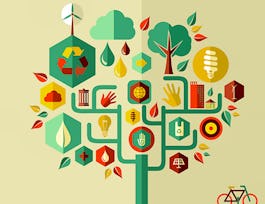Integrated landscape management and large-scale landscape restoration should be in every company’s business strategy because in order to reach the Sustainable Development Goal on Land Degradation Neutrality (SDG Number 15.3) scaling up and acceleration of business-driven landscape restoration is urgently needed.
This requires business professionals with a vision, the right knowledge and skills. This MOOC aims to train the next generation of business professionals and developers to acknowledge business’ interdependency with healthy landscapes and understand the value of ecosystem resources. “Historically, we have found countless ways to justify our continued exploitation of the environment: discovery, tradition, Manifest Destiny, even Chinese hoax. But we’re all out of excuses now. Each passing day swells the data on greenhouse gases and extreme weather, shrinking reservoirs and rising sea levels, and diminishing biodiversity. Our resources are finite, the window for change if not firmly shut, is certainly closing, and all life must adapt or be doomed.” Téa Obreht, The New Yorker, Dec. 19&26, 2016, p. 106. It is a frightening prospect indeed – that all life on Earth must either adapt or be doomed. This course is about landscape degradation – a global and wicked problem that is contributing to the dooming prospect of depletion of Earth’s finite resources. But this course is also about the solutions to this problem – business driven landscape restoration. So rather than leaving you powerless with the prospect Obreht puts fowards above, it is our hope that you learn how you can be part of the solution to making sure that Planet Earth still provides a safe and habitable home for future generations. We must act big and we must act now. With this course we want to pass on valuable knowledge and teach you useful skills that you can apply in your professional life that will enable you to tackle the issue of landscape degradation and restoration. The issue is urgent, so let’s dive right into it. This MOOC is developed by the ENABLE partnership, which is co-funded by the ERASMUS+ programme of the European Commission and involves a diverse, international group of organizations including Rotterdam School of Management, Erasmus University, Commonland, United Nations University Land Restoration Training Programme, the Spanish National Research Council and Estoril Global Conferences.
![Taipei Medical University [TMU]](https://d3njjcbhbojbot.cloudfront.net/api/utilities/v1/imageproxy/https://coursera-university-assets.s3.amazonaws.com/39/652e1d2689412c857734675326354d/72x72.png?auto=format%2Ccompress&dpr=1&w=160&h=32)
























